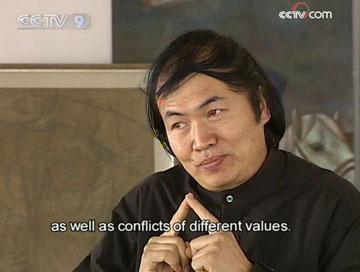
For two years, the young Chao shepherded sheep and taught the children of herdsmen before he enrolled at the Central Academy of Fine Arts in Beijing. After graduation, he returned to his hometown. He says that wandering each day with the sheep in the constant sunshine was the most pleasant and soothing experience of his life.
Chao said, "This was the most precious part of my life. Of all the memories I have about growing up, the most important one is returning to the Mongolian grassland. I used the simplest way of painting to create a poetic artistic world."
Later in his career, he constantly explored his emotional connection with the Mongolian landscape in paintings of the vast steppe and its grand mountains. In these works, viewers can see a faithful emotion to a perpetual, lofty beauty which is almost akin to religious feeling.
Chao said, "Inner Mongolia boasts high skies and a vast expanse of earth as well as its unique history. It's like a ray of sunshine for me. I have gained strong emotional influences from my Mongolian life and my differing lifestyles. All of this has helped my art to progress."
One of the most important figures of the 1990s on the Chinese arts scene, Chao made a quiet but essential artistic change in 2000.
The strong, tense moods defining his earlier works were greatly subdued, while a serene, solemn and reserved atmosphere crept onto his canvases.
Chao said, "After I finished my paintings, many friends told me that they had similar feelings. This shows that such feelings are not individual, but instead belong to a group of people and an entire society. This is why art is so valuable."
Over the years, Chao Ge travelled extensively around the world to absorb artistic inspirations. He held a solo exhibition at the Vittoriano Complex in Rome in June 2006, which created quite a stir among the Italian art community.
Chao said, "I told her that I learnt it in China, but I travelled a lot around the world. So I have a relatively deep knowledge about world art."
"It’s more difficult for us to get to know each other spiritually than materially. Therefore, such an exchange allows everyone to know how the people of that land live their psychological lives."
Given that his portraits feature people tense with anxiety and inner struggle, it's almost baffling to see Chao in person and discover what a quiet and self-composed man he is. But Chao admits that he does his best to hide his tormented soul with a mild-mannered appearance.
Chao always expected that a new artistic experiment would mean challenging the established aesthetic tastes and habits, but he still hadn't expected it to be so lonely and strenuous a battle.
But he says that now that he's embarked on his expressionist crusade, he will never turn back. He's determined to create something possessing a more abiding spiritual grace and distinction, something that can endure posterity's critical gaze forever.
(CCTV March 18, 2009)